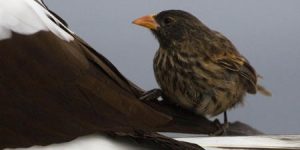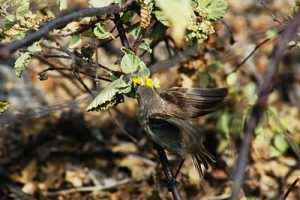
Finches are found in a variety of colors and personalities — from colorful Gouldian finches to the sociable society finch. These little birds can make wonderful avian companions if given the right housing (a spacious flight cage or aviary, please!), the right food (did you know Lafeber makes food just for finches?!) and the same level of care afforded to other pets. But there’s one finch you might not want in the home, especially if you have other pets — the vampire finch.
 The vampire finch (Geospiza difficilis septentrionalis) got its nickname from the way it has adapted to supplement its diet, which is to use its sharp bill to peck away at the backside of other animals (namely two types of sea birds, the Nazca booby and the blue-footed booby), and drink their blood. The theory goes that this “blood thirst” behavior first began as a pecking behavior that the finches used to clean parasites from the booby’s feathers, but they adapted to supplement their diet with the booby’s blood. A key word here is “supplement” … the vampire finch consumes other foods, such as seeds and invertebrates.
The vampire finch (Geospiza difficilis septentrionalis) got its nickname from the way it has adapted to supplement its diet, which is to use its sharp bill to peck away at the backside of other animals (namely two types of sea birds, the Nazca booby and the blue-footed booby), and drink their blood. The theory goes that this “blood thirst” behavior first began as a pecking behavior that the finches used to clean parasites from the booby’s feathers, but they adapted to supplement their diet with the booby’s blood. A key word here is “supplement” … the vampire finch consumes other foods, such as seeds and invertebrates.
This rare finch is indigenous to the Galapagos Islands, which is home to 14 finch species collectively referred to as Darwin’s finches, and they are often cited as examples of natural selection related to adaptation. Ironically, another finch in the vampire finch’s habitat is the vegetarian finch (Platyspiza crassirostris), which is primarily a plant eater.

Ghost Birds
There have been a few ghost bird sightings throughout the years, and before the you pick up the phone to call the bird division of Ghostbusters, know that a “ghost bird” is a rare species that eludes discovery or re-discovery. A famous ghost bird that made the news rounds in the U.S. was the ivory-billed woodpecker (Campephilus principalis), one of the world’s largest woodpeckers and native to the southeastern United States.
Sadly, like many other bird species, habitat loss is credited to wiping out the ivory woodpecker’s population, to the degree that the International Union for Conservation of Nature(IUCN) lists it as critically endangered and possibly extinct, with the American Birding Association (ABA) going a step further and listing it lists as a Class 6 species, a category the ABA defines as “definitely or probably extinct.”
A reported sighting of the bird in 2004 in Arkansas sparked a multi-million dollar search, which, according to an Audubon online reporting, “led to several follow-up sightings, a blurry video, and a firestorm of media announcing that the Ivory-bill had been rediscovered. But when the team failed to find indisputable evidence, the throngs of searchers recoiled and the Ivory-bill was tucked back into the drawer with all the other museum specimens of bygone birds.” Audubon is currently hosting a blog titled, “The Quest for the Ivory-billed Woodpecker Heads to Cuba. Can two determined birders track down the most elusive—and possibly extinct—bird out there?” You can follow its daily blog to find out.
One ghost bird that was not only found but photographed, proving its existence, is the elusive moustached kingfisher. Chris Filardi, a bird expert at the American Museum of Natural History’s Center for Biodiversity and Conservation, and his team spent two decades searching for the elusive bird that was found in the remote forests in the Solomon Islands.
In his blog post, Filardi described a ghost bird such as the moustached kingfisher, “We search for them in earnest but they are seemingly beyond detection except by proxy and story. They are ghosts, until they reveal themselves in a thrilling moment of clarity and then they are gone again. Maybe for another day, maybe a year, maybe a century.”
For many bird enthusiasts, the story has a bittersweet ending. Filardi euthanized the bird to collect it, which has traditionally been the scientific standard for documenting a species existence. The act stirred a great deal of controversy. This article, published online at Independent.co.uk, offers an extensive look at the debate that ensued.





